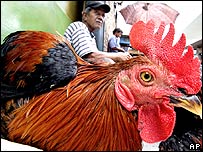 |
|
The number of deaths from H5N1 in Indonesia has reached 30 (Image: BBC) |
Currently, it remains unclear how this group of individuals contracted the disease, which is crucial information. So far, testing of other villagers, including friends and neighbors of the victims, has indicated that the virus has not spread further.
However, a spokesperson for the World Health Organization (WHO) stated to the BBC that whenever there is a group of infected individuals, it raises concerns about the potential for the virus to transmit from person to person.
In the latest cases in Indonesia, the patients were all related, although they were from three different households within the same village, where poultry is raised freely.
To date, testing on local poultry has not shown any signs of the H5N1 virus. However, these cases raise larger questions about how Indonesia is dealing with avian influenza.
Indonesia has a large poultry population, both in industrial farming and small-scale farming. Most of the infections reported so far have involved small household farms—typically chickens raised in backyards or allowed to roam freely. The spread of avian influenza to remote areas across the Indonesian archipelago makes it very challenging to monitor.
A WHO spokesperson in Indonesia stated that the country has made significant progress since the first reported death from the H5N1 virus.
Additional healthcare workers have been trained to identify and treat avian influenza cases, and hospital facilities have also been improved. However, the WHO spokesperson emphasized that as long as the virus continues to circulate in poultry, it poses a threat to human health.



















































